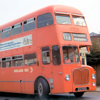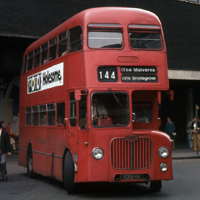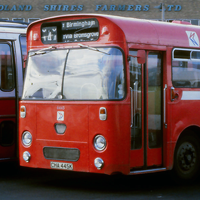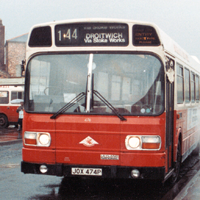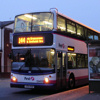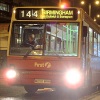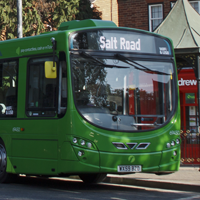Service 144: Service History
Page Content
- Service 144 operated by Birmingham & Midland Motor OC Ltd. (1928–1974)
- Service 144 operated by Midland Red OC Ltd. (1974–1981)
- Service 144 operated by Midland Red (West) Ltd. (1981–1986)
- Service 144 operated by Midland Red West Ltd. (1986–1999)
- Service 144 operated by First Midland Red Buses Ltd. (1999–2018)
- Service 144 operated by First Midland Red Buses Ltd. (2018— )
Service 144 (1928–1974)
Operated by Birmingham and Midland Motor Omnibus Company Limited
On Saturday 11th February 1928 the Birmingham and Midland Motor Omnibus Company Limited (BMMO—Midland “Red” Motor Services) renumbered their entire network and at this time the Birmingham to Malvern Wells Service 125 was renumbered to Service 144. Buses operated every 45-minutes in each direction throughout the week, but additional journeys were added on certain days when extra demand was expected.
In the New Year of 1929, BMMO announced they were to scrap all their double-deck buses and services would be operated with what the company called “luxury coach-buses”, which they claimed are “most comfortable and capable of doing 40 m.p.h. on a clear road”. Thus saw the withdrawal of the petrol-electric open-top Tilling-Steven FS class of vehicle from the route (and within a year from the whole company) and the introduction of much more modern single-deck buses designed and built by BMMO. With the new, faster vehicles in service, BMMO cut the running time from Birmingham to Malvern Wells on Saturday 12th January 1929 by an impressive 34 minutes, to just 2 hours and 20 minutes. January 1929 also saw the opening of a new depot in Birmingham, and from this time the new Birmingham (Digbeth) depot operated buses from the Birmingham end of the route.
Until January 1930, all local BMMO operations in Malvern had been run by Worcester depot, but from this time the company leased a small garage in Portland Road, Malvern, from W. & B. Woodyatt Limited, having taken over their coach tour operations the previous year. The garage was operated as an outstation or “dormy garage” of Worcester depot and provided vehicles for use on Service 144 from the Malvern end, but this site was not suitable for double-deck vehicles so once the type was re-introduced on the route Malvern “dormy garage” only operated certain morning short-workings with single-deck buses. A full Malvern depot opened on Friday 10th September 1954 and from that time always provide three double-deck vehicles for the route until it closed.
In the early 1930s, buses ran every 45-minutes in each direction during the week and on Sunday mornings, with additional buses on Sunday evenings to provide a 30-minute frequency. On Saturdays buses ran every 30-minutes in the mornings, and every 20-minutes during the afternoons and evenings.
BMMO's idea of running their entire fleet with single-deck vehicles didn't last long and from 1932 the company started to build their own design of double-deck vehicles, the SOS“DD(RE)”, followed by the SOS “DD(FE)” from 1934. The introduction of more modern vehicles on Service 144 resulted in growing demand for the service and frequency was increased to run every 30-minutes in each direction during the week, then later to every 20-minutes, Sundays to Fridays, with extra buses on Saturdays to bring the frequency to every 15-minutes. This timetable remained virtually unchanged until the mid-1960s.
Before the Second World War, an inspector would be based to the Malvern Wells terminus to oversee the unloading and loading of passengers and ensure vehicles departed on time. At busy times the inspector would be required to telephone local garages to send duplicate vehicles, and under such circumstances, it was sometimes possible to see a bus from Hereford depot depot operating a Service 144.
Service 144 continued to run during the Second World War, but on Saturday 7th October 1939, local Malvern Service M22 which ran between Great Malvern, Belmont, and Malvern Link was withdrawn due to wartime fuel rationing so from this date certain journeys on Service 144 were diverted to run via Belmont as a replacement. Service M22 was reinstated with a much-reduced timetable on Monday 11th December 1939 allowing some, but not all, Service 144 journeys to return to the normal route. There were further timetable changes on Saturday 1st June 1940, on Saturday 13th July 1940, and again on Saturday 28th September 1940.
In the 1960s, with the rapid growth in private car ownership, roads were upgraded to cope with the increased traffic levels. Between Powick and Malvern Link the original twisty road was replaced with a much wider and direct road allowing vehicles to run more quickly. Parts of the old road can still be seen in places, such as Newland and outside the Halfway House Inn. A similar road layout change was near Lickey End where the road was upgraded to become a dual-carriageway and rerouted to connect with the new M5 motorway, which opened in July 1962. Other than changes imposed by new road layouts, the route of Service 144 remained unchanged throughout it's history. However, a Bank Holiday variation to Service 144 was introduced following the opening of the M5 motorway that ran as Service 188 using the new motorway to provide a direct link between Birmingham and The Malverns for day-trippers. This was in addition to the daily hourly Service X44 that provided a directly link between Birmingham and Worcester via the M5 motorway.
Route Summary
- Mar 1928–Mar 1974
- Birmingham
- Rubery
- Bromsgrove
- Wychbold
- Droitwich Spa
- Fernhill Heath
- Worcester
- Powick
- Malvern Link
- Great Malvern
- Malvern Wells
| 1 | 4 | 4 |
Timetable Archive
| December | 1930 | Birmingham ↔ Bromsgrove ↔ Worcester ↔ Malvern Wells | |
| March | 1932 | Birmingham ↔ Bromsgrove ↔ Worcester ↔ Malvern Wells | |
| April | 1933 | Birmingham ↔ Bromsgrove ↔ Worcester ↔ Malvern Wells | |
| June | 1940 | Birmingham ↔ Bromsgrove ↔ Worcester ↔ Malvern Wells | |
| June | 1957 | Birmingham ↔ Bromsgrove ↔ Worcester ↔ Malvern Wells | |
| March | 1972 | Birmingham ↔ Bromsgrove ↔ Worcester ↔ Malvern Wells |
Service 144 (1974–1981)
Operated by Midland Red Omnibus Company Limited
On Monday 3rd December 1973, Birmingham and Midland Motor Omnibus Company Limited (BMMO—Midland “Red” Motor Services) sold a number of depots and their operations to the West Midlands Passenger Transport Executive (WMPTE). As a result of this, the company renamed to Midland Red Omnibus Company Limited (MROC) on Friday 29th March 1974.
The Service 144 route followed what is today the A38 from Birmingham to Worcester and then the A449 through Malvern to Malvern Wells. The only major change came on Friday 1st October 1976 when National Bus Company cutbacks saw the closure of Malvern depot. With that came an entirely new network of services in and around Malvern, operated by Worcester depot, and the Worcester to Malvern Wells section of Service 144 was abandoned.
The closure of Malvern depot and the withdrawal of the Worcester to Malvern Wells section of the route also saw Service 144 finally converted to one-man operation starting on Saturday 2nd October 1976. The route was one of the last to be converted by Midland Red and had remained as crew operation because of the difficult reverse turn at the Malvern Wells terminus, which required the conductor to stand in the road and stop oncoming traffic, whilst guiding the bus safely back.
With the introduction of the Severnlink MAP scheme on Saturday 13th January 1979, the Worcester to Malvern section of the route was re-introduced but did not run direct between Malvern Link and Great Malvern, and now served Pound Bank and Barnards Green. This was not successful as delays on the Birmingham to Worcester section of the route caused reliability problems on the Worcester to Malvern section and, after only 5 months, the Worcester to Malvern section was again abandoned. Links between Birmingham and The Malverns were maintained by extending “Motorway Express” Service X43 and Service X44, as Service M43 and Service M44. These only ran hourly so additional capacity was provided by new Service 344 running over the old Service 412 route between Worcester and Great Malvern.
Midland Red Omnibus Company Limited (MROC) ceased trading as a bus and coach operator at the end of services on Saturday 5th September 1981. From the following day, all journeys of Service 144 were operated by the newly formed Midland Red (West) Limited.
For details of this route after 1981, see Midland Red West Service 144.
Route Summary
- Mar 1974–Sep 1976
- Birmingham
- Rubery
- Bromsgrove
- Wychbold
- Droitwich Spa
- Fernhill Heath
- Worcester
- Powick
- Malvern Link
- Great Malvern
- Malvern Wells
- Oct 1976–Jan 1979
- Birmingham
- Rubery
- Bromsgrove
- Wychbold
- Droitwich Spa
- Fernhill Heath
- Worcester
- Jan 1979–May 1979
- Birmingham
- Rubery
- Bromsgrove
- Wychbold
- Droitwich Spa
- Fernhill Heath
- Worcester
- Powick
- Malvern Link
- Pound Bank
- Barnards Green
- Great Malvern
- May 1979–Sep 1981
- Birmingham
- Rubery
- Bromsgrove
- Wychbold
- Droitwich Spa
- Fernhill Heath
- Worcester
| 1 | 4 | 4 |
Timetable Archive
| January | 1981 | Birmingham ↔ Bromsgrove ↔ Worcester |
Service 144 (1981–1986)
Operated by Midland Red (West) Limited
At the end of services on Saturday 5th September 1981, Midland “Red†Motor Service (officially called Midland Red Omnibus Company Limited by this time) ceased trading as a bus and coach operator. From the following day, all stage carriage bus services were divided between four new operating companies, with the operation of all Service 144 journeys, with the depots, staff and vehicles etc to operate them, passing to the newly formed Midland Red (West) Limited.
The route, timetable and vehicles were initially unchanged from those of Midland Red Omnibus Company Limited (MROC), with most journeys being operated by either Worcester depot or Bromsgrove depot, with one journey every 30-minutes in each direction throughout the day between Birmingham, Bromsgrove and Worcester. Service 143 continued to be interworked over a similar route between Birmingham and Bromsgrove giving a 15-minute frequency on most of that section of the route. On Friday 16th September 1983, Midland Red (West) Limited closed Bromsgrove depot and from this time most journeys of Service 144 were operated by Worcester depot. However, some journeys that had previously been operated by Bromsgrove depot passed to Kidderminster depot, but these were mostly short-working journeys that started or finished in Bromsgrove or Marlbrook.
The original Service 144 had been fully converted to one-man operation by MROC in October 1976, and from this time all journeys were operated using Leyland National singe-deck buses, although there were still a number of Leyland Leopard dual-purpose buses in the fleet so I imagine some of those found their way on to the 144 at times. Midland Red (West) Limited was owned by National Bus Company (NBC) throughout this period and vehicle livery was NBC “Poppy Red†with a white band above the windows to show the NBC logo and “Midland Red West†company name, although adoption of the word “West†was a bit slow so initially many vehicles still just showed the name “Midland Redâ€.
MROC had introduced their “Severnlink†MAP scheme on Saturday 13th January 1979, and vehicles operated on Service 144 operated with Severnlink branding shown in the white band above the windows. The branding was also used on ticketing and timetables, and this was initially continued by Midland Red (West) Limited but was phased out from July 1984.
Route Summary
- Sep 1981–Dec 1986
- Birmingham
- Rubery
- Bromsgrove
- Wychbold
- Droitwich Spa
- Fernhill Heath
- Worcester
| 1 | 4 | 4 |
Timetable Archive
| August | 1986 | Birmingham ↔ Bromsgrove ↔ Worcester |
Service 144 (1986–1999)
Operated by Midland Red West Limited
On Monday 22nd December 1986, the business and operations of Midland Red (West) Limited were privatised when they were sold by the National Bus Company (NBC) to a team of managers led by the late Mr Ken Mills. The newly privatised company was known as Midland Red West Limited (without brackets around the word “Westâ€) and a new company livery was introduced of Ayre's Red and Off-White, with a Wyvern logo. The NBC logo was quickly removed from all vehicles and the “Poppy Red†livery was phased out over the next few years.
Midland Red Coaches Limited became part of Midland Red West at the same time, and with that company came the lease of Birmingham (Digbeth) depot. A small number of journeys were operated from there, although there were strong demands on Digbeth for Birmingham and Black Country services so these were mostly only short-working journeys between Birmingham and Bromsgrove, with the large majority of working remaining with Worcester depot. At times, Redditch depot also operated off-peak short-working journeys.
The majority of journeys continued to be operated using Leyland National single-deck buses, but certain off-peak journeys were interworked with the X41–X44 group of “Motorway Express†services between Birmingham and The Malverns, so were operated using Leyland Leopard coaches or dual-purpose buses.
On Sunday 1st September 1996, Service 144 was once again extended to provide a direct link between Birmingham and The Malverns, but only on Sundays. The Sunday extension to the service ran over the same route as Service 44, but then continued past Great Malvern to British Camp. From Sunday 29th June 1997, a connection was available with Service 244 operated by Boomerang Bus Company (Warner) of Tewkesbury to provide links to Rye Cross and Ledbury.
Route Summary
- Dec 1986–Aug 1996
- Birmingham
- Rubery
- Bromsgrove
- Wychbold
- Droitwich Spa
- Fernhill Heath
- Worcester
- Sep 1996–Mar 1999
- Birmingham
- Rubery
- Bromsgrove
- Wychbold
- Droitwich Spa
- Fernhill Heath
- Worcester 1
- Powick
- Malvern Link
- Pound Bank
- Barnards Green
- Great Malvern
- Malvern Wells
- British Camp
1 Certain journeys continued to Great Malvern or British Camp on Sundays only.
| 1 | 4 | 4 |
Timetable Archive
| September | 1991 | Birmingham ↔ Bromsgrove ↔ Worcester |
Service 144 (1999–2018)
Operated by First Midland Red Buses Limited
Service 144 had remained largely unchanged while operated by Midland Red West. However, on Sunday 20th June 1999, shortly after the company became First Midland Red Buses Limited, the Birmingham Bull Ring Bus Station was closed and the terminus moved to Smallbrook Queensway.
From 2004, First Midland Red Buses Limited made a series of changes to Service 144. The first of these came on Sunday 1st February 2004 when the Sundays only extension to The Malverns was withdrawn with all Sunday journeys once again terminating at Worcester. The section of the route between Worcester and The Malverns was replaced by additional Service 44 journeys.
On Sunday 18th April 2004, First Midland Red re-routed Service 144 in Bromsgrove to run through Catshill, running via Stourbridge Road, Meadow Road and Golden Cross Lane, with Birmingham Road no longer being served. On Sunday 4th September 2005, the frequency was increased to run every 20-minutes in each direction, with short-working journeys between Worcester and Droitwich Spa only as Service 244 from Tuesday 1st September 2009.
The frequency of Service 144 was increased to run every 15-minutes in each direction between Worcester, Droitwich Spa, Bromsgrove, and Catshill on Monday 6th September 2010, with every second journey continuing to Birmingham with a 30-minute frequency on that section of the route. Service 244 between Worcester and Droitwich Spa was withdrawn at this time.
The short-working journeys that terminated at Catshill additionally served the Princess of Wales Hospital grounds in Bromsgrove. From Monday 3rd June 2013 these short journeys were renumbered to Service 144A and also operated via the grounds of Webbs Garden Centre near Wychbold.
From September 2014, certain journeys of Service 144A were extended to Halesowen as Service 147, but this was short-lived and Service 147 was withdrawn on Sunday 10th April 2016. From the same time, Service 144A no longer ran via the Princess of Wales Hospital when all journeys were diverted via Broad Street.
From Sunday 4th September 2016, First Midland Red Buses Limited changed the bus stops served in Birmingham, with some historic but lightly used stops being removed, and a few new stops being added.
Route Summary
- May 1999–Feb 2004
- Birmingham
- Rubery
- Bromsgrove
- Wychbold
- Droitwich Spa
- Fernhill Heath
- Worcester 1
- Powick
- Malvern Link
- Pound Bank
- Barnards Green
- Great Malvern
- Malvern Wells
- British Camp
- Feb 2004–Apr 2004
- Birmingham
- Rubery
- Bromsgrove
- Wychbold
- Droitwich Spa
- Fernhill Heath
- Worcester
- Apr 2004–Sep 2010
- Birmingham
- Rubery
- Catshill
- Bromsgrove
- Wychbold
- Droitwich Spa
- Fernhill Heath
- Worcester
- Sep 2010–Jun 2013
- Birmingham
- Rubery
- Catshill 2
- Bromsgrove
- Wychbold
- Droitwich Spa
- Fernhill Heath
- Worcester
- Jun 2013–Jun 2018
- Birmingham
- Rubery
- Catshill
- Bromsgrove
- Wychbold
- Droitwich Spa
- Fernhill Heath
- Worcester
1 Certain journeys continued to Great Malvern or British Camp on Sundays only.
2 Short-working journeys start/finish at Green Lane, Catshill, and run via Princess of Wales Hospital grounds. These journeys are renumbered to Service 144A from 3rd June 2013.
| 1 | 4 | 4 |
Timetable Archive
| September | 2009 | Birmingham ↔ Bromsgrove ↔ Worcester | |
| September | 2015 | Birmingham ↔ Bromsgrove ↔ Worcester | |
| April | 2016 | Birmingham ↔ Bromsgrove ↔ Worcester |
Service 144 (2018— )
Operated by First Midland Red Buses Limited
On Saturday 9th June 2018, at a launch event in Birmingham City Center, First Midland Red Buses Limited re-branded their historic Service 144 to “Salt Road”, and stated that the route number 144 would be phased out. The name of Salt Road was chosen in recognition of the route used since Roman times to transport salt from the brine springs at Droitwich Spa to the Roman Market Town at Worcester to the south, and to Metchley Fort (near modern-day Edgbaston) to the north.
The announcement about the phasing out of the route number was not very popular with either staff or enthusiasts, and even representatives of Centro expressed concerns that their road-side route information would not work with route numbers longer than four digits. It is unclear if First Midland Red still intend to phase out the route number, but over two years later the historic 144 number is still in use.
As part of the re-brand to “Salt Roadâ€, First Midlands moved a number of Volvo single-deck buses to First Midland Red's Worcester depot, and these were refurbished inside and out, receiving an overall green livery with Salt Road branding. The following year, the buses were all named after Roman Goddesses.
Shortly after the buses were named, Service 144 we cut back, with the Birmingham to Bromsgrove section of the route now only running every hour. Then from Sunday 1st May 2022, the Catshill to Birmingham section of the route was withdrawn entirely, but with funding from Worcestershire County Council and Centro a partial replacement has been offered by National Express West Midlands, running every 70-minutes between Bromsgrove, Rubery, and Longbridge.
Route Summary
- Jun 2018–Apr 2022
- Birmingham
- Rubery
- Catshill
- Bromsgrove
- Wychbold
- Droitwich Spa
- Fernhill Heath
- Worcester
- May 2022—
- Catshill
- Bromsgrove
- Wychbold
- Droitwich Spa
- Fernhill Heath
- Worcester
